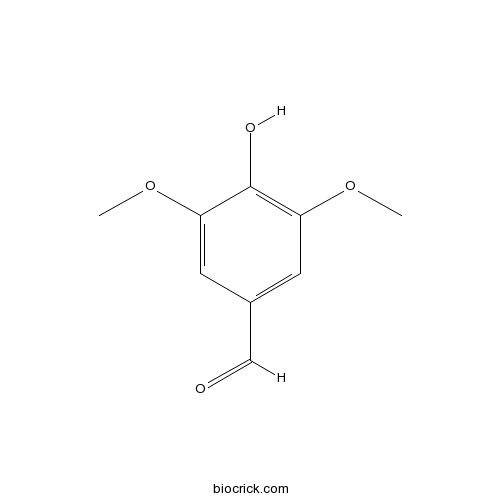Schima superba
Schima superba
1. The products in our compound library are selected from thousands of unique natural products; 2. It has the characteristics of diverse structure, diverse sources and wide coverage of activities; 3. Provide information on the activity of products from major journals, patents and research reports around the world, providing theoretical direction and research basis for further research and screening; 4. Free combination according to the type, source, target and disease of natural product; 5. The compound powder is placed in a covered tube and then discharged into a 10 x 10 cryostat; 6. Transport in ice pack or dry ice pack. Please store it at -20 °C as soon as possible after receiving the product, and use it as soon as possible after opening.
Natural products/compounds from Schima superba
- Cat.No. Product Name CAS Number COA
-
BCN6186
4-Hydroxy-3,5-dimethoxybenzaldehyde134-96-3
Instructions

[Effects of neighbor competition on growth, fine root morphology and distribution of Schima superba and Cunninghamia lanceolata in different nutrient environments].[Pubmed: 29745178]
以木荷和杉木为试验材料,模拟异质和同质两种森林土壤养分环境,设计单植、两株纯植和两株混植3种栽植方式,开展盆栽试验研究木荷与杉木混交造林增产及木荷生长竞争优势形成的原因.结果表明: 与同质养分环境相比,异质养分环境中木荷与杉木混植时两树种均具有较高的苗高和干物质积累量,且木荷竞争优势明显,这与其根系可塑性强有关.混植的木荷各径级细根大量增生,其根系总长度、表面积和体积比杉木高80%~180%.木荷细根在垂直方向上采用了补偿性的生长策略,即除占据富养表层外,还在低养分斑块中大量增殖以获得更大的竞争优势.木荷与杉木的细根在土壤中的拓殖深度不同,生态位分化,缓解了两树种根系对养分的强烈竞争,提高了混植产量.纯植的木荷由于根系自我识别作用,抑制了根系的生长,使得纯植产量较低.细根在空间上错开和均匀分布可能是木荷纯林结构稳定的原因之一.建议在生产中采用块状整地和表层施肥等措施,改善土壤养分分布状况,营建混交林促进木荷和杉木生长,而对已营造的木荷人工纯林,可以及时调控林分密度促进林木生长.
[Different responses of growth and root development of Schima superba provenance to the adjacent plant competition in different nutrient conditions].[Pubmed: 29741303]
研究同质和异质养分环境中邻株竞争对3个木荷种源生长和根系发育的影响,揭示了不同种源木荷生长竞争能力差异原因.结果表明: 与同质养分环境相比,3个木荷种源在异质养分环境中具有苗高生长量大、干物质积累量高和根系增生明显等特点.在异质养分环境下,福建建瓯种源木荷苗木生长量显著高于浙江龙泉和江西信丰种源,与杉木混植时尤为突出,这与其根系形态可塑性高和拓殖能力强有关,混植时,福建建瓯种源木荷的根长、根表面积和根体积等根系生长量较单植显著增长20.4 %~69.0%,其根系在富养表层大量增生的同时快速向深层贫养层拓殖,占有了更多的空间和资源,提高了觅养能力,使其生长优势更为明显,而浙江龙泉和江西信丰种源根系生长和深层土壤根系分布受邻株竞争影响不同程度的降低.纯植时,可能由于根系自我识别作用,3个木荷种源的根系生长发育均受到抑制,导致福建建瓯种源苗木生长量显著减小,而浙江龙泉种源苗高和干物质积累增长明显,这与其根系生理可塑性有关.建议生产上选用觅养效率高和竞争能力强的福建建瓯种源木荷,采用混交造林的方式提高木荷人工林生产力.
Functional characteristics of phenolic compounds accumulated in young leaves of two subtropical forest tree species of different successional stages.[Pubmed: 29579301]
The abundance of phenolic compounds (including anthocyanins) in leaves is associated with photosynthetic performance, but the regulatory mechanism is unclear. Schima superba Gardn. et Champ. and Cryptocarya concinna Hance., which exhibit distinct anthocyanin accumulation patterns, are dominant tree species in the early- and late-successional stages, respectively, of subtropical forests in China. RNA-seq and analyses of phenolic concentrations, antioxidant capacity and photosynthetic characteristics were performed on young and mature leaves of these two species under contrasting light conditions. The high-light-acclimated young leaves of S. superba and C. concinna and low-light-acclimated young leaves of C. concinna were red. These red leaves had higher ratios of electron transport rate to gross photosynthesis (ETR:Pgross) and total antioxidant capacity to chlorophyll (TAC:Chl) than did the green leaves, regardless of light conditions. In addition, the red leaves had a higher expression level of the UDP-glucose:flavonoid 3-O-glucosyltransferase (UFGT) gene than did the green leaves, irrespective of light conditions. Total antioxidant capacity was positively correlated with flavonoid content in C. concinna leaves and with total phenolic content in leaves of both species under both high and low light. Consistent with the measurements of photosynthetic performance and flavonoids:Chl ratio, photosynthesis-related genes were extensively downregulated and flavonoid-pathway-related genes were extensively upregulated in young leaves relative to mature leaves. Under high and low light, both non-photochemical quenching and TAC:Chl, which serve as different types of photoprotective tools, were enhanced in young leaves of S. superba, whereas only TAC:Chl was enhanced in young leaves of C. concinna. Our results indicate that the biosynthesis of phenolic compounds in young leaves is likely enhanced by an imbalance between photosynthetic electron supply and demand and that flavonoids play a larger role in meditating photoprotection in late-successional species than in early-successional ones.
Effects of cadmium on photosynthesis of Schima superba young plant detected by chlorophyll fluorescence.[Pubmed: 29392606]
None


